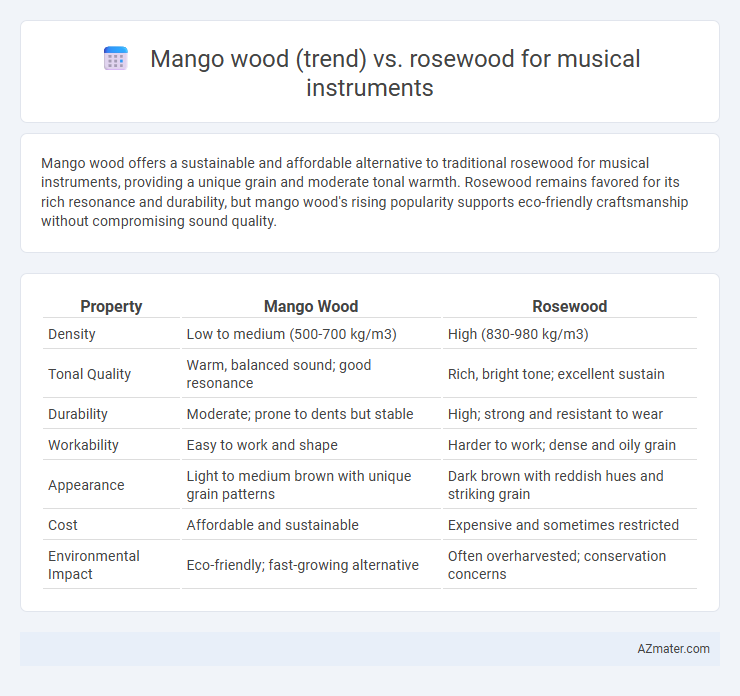Mango wood offers a sustainable and affordable alternative to traditional rosewood for musical instruments, providing a unique grain and moderate tonal warmth. Rosewood remains favored for its rich resonance and durability, but mango wood's rising popularity supports eco-friendly craftsmanship without compromising sound quality.
Table of Comparison
| Property | Mango Wood | Rosewood |
|---|---|---|
| Density | Low to medium (500-700 kg/m3) | High (830-980 kg/m3) |
| Tonal Quality | Warm, balanced sound; good resonance | Rich, bright tone; excellent sustain |
| Durability | Moderate; prone to dents but stable | High; strong and resistant to wear |
| Workability | Easy to work and shape | Harder to work; dense and oily grain |
| Appearance | Light to medium brown with unique grain patterns | Dark brown with reddish hues and striking grain |
| Cost | Affordable and sustainable | Expensive and sometimes restricted |
| Environmental Impact | Eco-friendly; fast-growing alternative | Often overharvested; conservation concerns |
Introduction: The Rise of Alternative Tonewoods
Mango wood has emerged as a popular alternative tonewood in musical instruments, valued for its sustainability, affordability, and visually attractive grain patterns compared to traditional rosewood. Rosewood remains favored for its rich tonal qualities and durability but faces restrictions due to CITES regulations, prompting luthiers to seek eco-friendly substitutes. The rise of mango wood addresses these concerns by offering comparable resonance and aesthetic appeal, making it a trending choice for guitars, ukuleles, and other stringed instruments.
Mango Wood vs Rosewood: Historical Context in Instrument Making
Mango wood, increasingly popular in contemporary musical instruments, offers sustainable and affordable alternatives compared to traditional rosewood, which has historical significance dating back centuries for its rich tonal qualities and durability. Rosewood has been favored for classical guitars, violins, and pianos due to its resonant sound and aesthetic grain, but restrictions on rosewood trade under CITES regulations have prompted artisans to explore mango wood for its similar acoustic properties and environmental benefits. The shift from rosewood to mango wood reflects evolving industry practices balancing historical craftsmanship with modern ecological considerations and sound performance.
Acoustic Properties: Comparing Sound Quality
Mango wood produces a warm, resonant tone with balanced mids and smooth highs, favored for its affordability and sustainability in acoustic guitars and ukuleles. Rosewood delivers richer overtones, greater sustain, and pronounced bass response, making it a premium choice for premium acoustic guitars and fingerboards. Both woods offer distinct acoustic properties, with mango wood providing a bright, articulate sound and rosewood excelling in depth and harmonic complexity.
Sustainability and Environmental Impact
Mango wood, sourced from mature mango trees no longer producing fruit, offers a sustainable alternative to Rosewood, which faces overharvesting and strict trade restrictions due to its endangered status. Mango wood's rapid growth and availability reduce environmental impact and support responsible forestry. In contrast, Rosewood harvesting contributes to deforestation and threatens biodiversity, making mango wood a more eco-friendly choice for musical instruments.
Aesthetic Appeal: Grain, Color, and Finish
Mango wood features a unique grain pattern with warm, golden hues and natural contrasting streaks that produce a rustic and artistic aesthetic, favored for contemporary musical instruments. Rosewood, prized for its darker, rich brown to purplish coloration and dense, fine grain, offers a classic, elegant finish that enhances the instrument's visual depth and luxurious appeal. The smooth finish of rosewood accentuates its natural luster, while mango wood's varied texture provides a distinctively organic and handcrafted look.
Workability: Crafting and Shaping Differences
Mango wood offers superior workability compared to rosewood due to its softer, less dense composition, allowing easier carving and shaping for musical instruments. Rosewood's dense, hard texture provides excellent tonal qualities but presents challenges in machining, often requiring specialized tools and more effort during crafting. These differences influence luthiers' choice, balancing ease of fabrication with desired acoustic properties.
Durability and Longevity in Musical Instruments
Mango wood offers moderate durability and longevity, making it suitable for affordable musical instruments, though it tends to be softer and less resistant to wear compared to rosewood. Rosewood is highly prized in musical instruments for its exceptional hardness, density, and natural oils, which provide superior durability, resistance to cracking, and long-lasting tonal quality. Instruments crafted from rosewood generally maintain their structural integrity and sound quality over decades, outperforming mango wood in terms of overall longevity.
Market Trends: Popularity Among Musicians and Manufacturers
Mango wood is gaining traction among musical instrument makers for its sustainable sourcing and affordability, appealing to eco-conscious musicians and budget-focused manufacturers. Rosewood remains a premium choice due to its superior tonal qualities and rich resonance, but trade restrictions and higher costs limit its accessibility. Market trends show a gradual shift as manufacturers increasingly explore mango wood alternatives to meet demand while navigating regulatory challenges affecting rosewood availability.
Cost Comparison and Availability
Mango wood offers a more affordable alternative to Rosewood for musical instruments, with prices typically 30-50% lower due to its faster growth and sustainable harvesting. While Rosewood remains highly prized for its rich tonal quality and rarity, supply restrictions under CITES limit its availability and increase costs. Mango wood's accessibility and eco-friendly profile make it a popular choice for budget-conscious luthiers and manufacturers seeking cost-effective materials without sacrificing durability.
Choosing Between Mango Wood and Rosewood: Key Considerations
Choosing between mango wood and rosewood for musical instruments depends on tone quality, durability, and environmental sustainability. Mango wood offers a warm, mellow sound with moderate density and is a more eco-friendly alternative due to its fast growth and availability. Rosewood delivers rich, resonant tones with superior hardness and natural oils, making it a preferred material for high-end instruments but faces restrictions under CITES regulations affecting its trade.

Infographic: Mango wood (trend) vs Rosewood for Musical instrument
 azmater.com
azmater.com